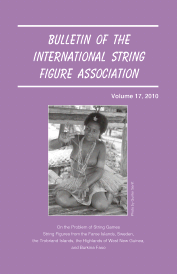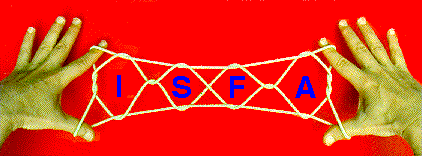Volume 17 (2010): 252 pages - Table des Matières
Edité par - Mark A. Sherman, Pasadena, California
Rédacteurs Associés - Joseph D'Antoni, Queens, New York; Myriam Namolaru, Haifa, Israel;
Belinda Holbrook, Davenport, Iowa; Stephan Claassen, Best, Netherlands.
Comité de Rédaction - Hiroshi Noguchi, Tokyo, Japan; Philip Noble, Inverness, Ecosse
Le Bulletin de l'Association Internationale du Jeu de Ficelle (BISFA) est une publication savante
présentant des documents originaux qui fait progresser notre compréhension et renforce
notre plaisir des jeux de ficelle. BISFA est publié annuellement, en septembre, par ISFA Press
(Pasadena, Californie). BISFA remplace le Bulletin de l'Association des Jeux de Ficelle,
(Toky Nippon Ayatori Kyokai), qui a été publiée en 19 volumes (1978-1993).
Les traductions proposées ne comprennent pas les illustrations et photos du texte original.
J'ai traduit ces textes pour vous donner un aperçu de la qualité et de la richesse de
ces publications.

Commentary
- On the problem of string games, especially in New Guinea by Georg Höltker. Translated by Axel Reichert, Bad Oldesloe, Germany, and Stephan Claassen, Best, the Netherlands (pages 1-18) - Georg Höltker SVD (1895-1976) was a German ethnologist and linguist. In 1936 he joined an expedition to Papua New Guinea and stayed there until 1939, doing research in the northern coastal area and the islands offshore. Upon returning to Germany he wrote an interesting article on the symbolic meaning of the region’s numerous string figures, which he titled “Zum problem der Fadenspiele, speziell in Neuguinea.” The article, written in German, was published in the 1942-43 issue of Bulletin der Schweizerischen Gesellschaft für Anthropologie und Ethnologie (volume 19, pages 1-21). Here we offer an English translation of Höltker’s article. Besides this article, Höltker wrote a number of publications on the tribes and languages of Papua New Guinea. During his career he worked for the Anthropos Institute and for several years was chief editor of its periodical Anthropos.
Research Reports
- Some string figures from the Faroe Islands by Kári Sverrisson, Saltangará, Faroe Islands, and Stephan Claassen, Best, the Netherlands (pages 19-37) - In the present article the authors describe eleven string figures and tricks from the Faroe Islands, which were collected on the islands in the summer of 2009 and in early 2010. Four of them appear to be original, not found elsewhere in the world, and two of them have not been described before. A short comparison with known string figure literature follows each figure.
- Swedish String Figures I: The 1939 Questionnaire from Lund (Southern Sweden) by Stephan Claassen, Best, the Netherlands (pages 38-71) - In 1939 a small questionnaire was distributed among the small-farmer community of southern Sweden. The results of this questionnaire are presented here. Many of the figures and tricks encountered are found also in other places in Europe and in the world. The Cat’s Cradle series (in Sweden called “att ta”) appears to be very popular in southern Sweden; one route in it is probably original. The questionnaire contains also a small two figure series for one player called “bordet/brevet”, which has until now not been described elsewhere in this form. A curious “figure” is the krampknut (“cramp-knot”), a string-knot with which the legs of chickens were tied when they had cramped feet. The article is based on material from The Folklife Archives in Lund, Sweden.
- Some Trobriand Islands string figures by Stephan Claassen, Best, the Netherlands, and Joseph D'Antoni, Queens, New York, USA, in cooperation with Gunter Senft, Max Planck Institute for Psycholinguistics, Nijmegen, Netherlands (pages 72-128) - The construction and execution of fourteen string figures from the Trobriand Islands is given, along with accompanying chants (in the original, and in translation) and comparative notes. The figures were made during a 1984 string figure performance by two ladies in the village of Tauwema, on the island of Kaile’una. The performance was filmed by a team of German researchers. One of the figures appears to be not recorded before, and the construction method of another figure was hitherto unknown. Some of the other figures have their own peculiarities.
- String figures from the Highlands of West New Guinea collected by Jules Camps, transcribed and annotated by Stephan Claassen, Best, the Netherlands. (pages 129-204) - In the 1970s Jules Camps OFM made two films on string figures while working as a missionary in the New Guinean highlands. One stems from the Grand Valley of the Balim river, the other from the Ilaga valley. Here transcriptions and reconstructions of twenty-one of the twenty-two different string figures in the films are presented, along with a short introduction and comparative notes. They are the first published construction methods for figures from West New Guinea. Six of the figures were hitherto unknown. In an Appendix, construction methods of two other string figures from the New Guinean highlands are presented. German researcher Irenäus Eibl- Eibesfeldt filmed them among the Eipo in 1979.
- A small collection of string figures and games from Burkina Faso by Sam Cannarozzi, Parcieux, France (pages 205-215) - The author presents nine different string figures and tricks that were collected in 2010 among various ethnic groups of Burkina Faso. He gives also an alternative construction method for one of them, which was collected in the 1990s in Mali. One figure, The Well in the Mecca, is the first figure the author has ever encountered that has an Islamic connotation.
Book and DVD Reviews - by Mark Sherman (pages 216-218)
- Cat’s Cradle and Other Fantastic String Figures, by Elizabeth Encarnacion.
- Ayatori, performed by Ai Noguchi. Introduced by Kyoko Maya.
Letters to the Editor (pages 219-228)
- Traditional Dutch String Figure Rediscovered - Stephan Claassen. Rediscovered method for making a traditional Dutch string figure called "Sliding Door" which appeared in a 1935 newspaper article.
- Henry Rishbeth (1931-2010) - Pril Rishbeth. Annoncement que le fils de Kathleen Haddon est mort en 2010.
- where is He? - Mark Sherman. Instructions for making two Easter Island string figures, gathered from Rapanui informants in 1997, plus a reconstructed method for making "where is He", a Rapanui string figure collected by Ramón Campbell.
- Ayatori Workshop update - Mariko Ohmi. Summary of ISFA founder Dr. Hiroshi Noguchi's teaching activities in 2008.
Modern String Figures (pages 229-231)
- Pierrot's Face - invented by Naoto Sato, Tokyo, Japan.
- A Squid - invented by Makoto Murase, Kobe City, Japan.
- A Gazelle's Face - invented by Makoto Murase, Kobe City, Japan.
Nomenclature - by Mark Sherman (pages 232-247)
- Abréviations et termes utilisés dans le Bulletin sont récapitulés et illustrés. Illustrations pas-à-pas pour réaliser cinq jeux de ficelle ( Regarde ! Tambour , Deux Faons , Masque , and Deux Pointes de Flèche ) sont donnés en exemples
Ajouter un commentaire






